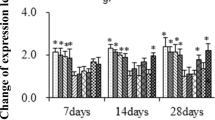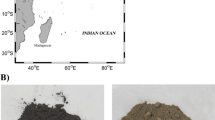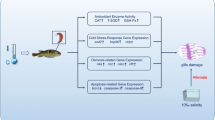Abstract
There is growing contamination of copper (Cu) in the marine environment, particularly after the ban of organotin compounds and the increase of the use of Cu-based antifouling paints. Although there are increasing research interests in temperature-dependent chemical toxicity to aquatic organisms, most existing studies focused on acute impacts of chemicals at high concentrations. This study aimed to investigate the interacting effect of temperature and copper exposure at environmentally relevant concentrations on survival and development in the marine copepod Tigriopus japonicus with a partial life-cycle toxicity test. Expressions of five stress response genes in the copepod, namely two glutathione S-transferases (GST-S and GST-O), two heat shock proteins (HSP70 and HSP90), and glutathione reductase (GR) were also investigated. The copepod’s survival was significantly impaired at 15 °C after development to adult stage, while its developmental time reduced significantly with increasing temperature. Copper at the two environmentally relevant test concentrations had no significant impacts on these apical endpoints whereas the interaction between Cu and temperature was more significant in modulating gene expressions. GST-S, GST-O and HSP90 genes in copepods exposed to 100 µg Cu L−1 were significantly upregulated at 20 °C. At 32 °C, most genes were either insignificantly expressed or down-regulated, compared to the control, likely suggesting that thermal stress inhibited the copepod’s antioxidative defense system. Overall, the results revealed that the joint Cu and thermal stresses have significantly elicited antioxidative system in the copepods. It clearly demonstrated the need for more fundamental studies about potential impacts of different environmental factors such as temperature on chemical toxicity under realistic scenario of marine pollution.


Similar content being viewed by others
References
Almroth BC, Asker N, Wassmur B, Rosengren M, Jutfelt F, Gräns A, Sundell K, Axelsson M, Sturve J (2015) Warmer water temperature results in oxidative damage in an Antarctic fish, the bald notothen. J Exp Mar Biol Ecol 468:130–137
Bao VWW, Leung KMY, Qiu JW, Lam MHW (2011) Acute toxicities of five commonly used antifouling booster biocides to selected subtropical and cosmopolitan marine species. Mar Pollut Bull 62:1147–1151
Brown A, Thatje S, Hauton C (2017) The effects of temperature and hydrostatic pressure on metal toxicity: Insights into toxicity in the deep sea. Environ Sci Technol 51:10222–10231
Brown RJ, Galloway TS, Lowe D, Browne MA, Dissanayake A, Jones MB, Depledge MH (2004) Differential sensitivity of three marine invertebrates to copper assessed using multiple biomarkers. Aquat Toxicol 66:267–278
Chan BKK (2000) Diurnal physico-chemical variations in Hong Kong rock pools. Asian. Mar Biol 17:43–54
Clarke KR, Gorley RN (2015) Getting started with PRIMER v7. PRIMER-E: Plymouth, Plymouth Marine Laboratory, 20.
Dafforn KA, Lewis JA, Johnston EL (2011) Antifouling strategies: History and regulation, ecological impacts and mitigation. Mar Pollut Bull 62:453–465
Ensibi C, Yahia MND (2017) Toxicity assessment of cadmium chloride on planktonic copepods Centropages ponticus using biochemical markers. Toxicol Rep 4:83–88
Gaetke LM, Chow CK (2003) Copper toxicity, oxidative stress, and antioxidant nutrients. Toxicology 189:147–163
Häder DP, Banaszak AT, Villafañe VE, Narvarte MA, González RA, Helbling EW (2020) Anthropogenic pollution of aquatic ecosystems: Emerging problems with global implications. Sci Total Environ 713:136586
Han J, Jeong CB, Byeon E, Lee JS (2018a) Effects of temperature changes on the generation of reactive oxygen species and the expression and activity of glutathione-S transferases in two congeneric copepods Tigriopus japonicus and Tigriopus kingsejongensis. Fish Sci 84:815–823
Han J, Lee JS, Park JC, Hagiwara A, Lee KW, Lee JS (2020) Effects of temperature changes on life parameters, oxidative stress, and antioxidant defense system in the monogonont marine rotifer Brachionus plicatilis. Mar Pollut Bull 155:111062
Han J, Lee MC, Park JC, Kim S, Lee JS (2018b) Effects of temperature shifts on life parameters and expression of fatty acid synthesis and heat shock protein genes in temperate and Antarctic copepods Tigriopus japonicus and Tigriopus kingsejongensis. Polar Biol 41:2459–2466
Heine KB, Abebe A, Wilson AE, Hood WR (2019) Copepod respiration increases by 7% per °C increase in temperature: A meta‐analysis. Limnol Oceanogr Lett 4:53–61
Karlsson K, Puiac S, Winder M (2018) Life-history responses to changing temperature and salinity of the Baltic Sea copepod Eurytemora affinis. Mar Biol 165:1–11
Kim BM, Rhee JS, Jeong CB, Seo JS, Park GS, Lee YM, Lee JS (2014) Heavy metals induce oxidative stress and trigger oxidative stress-mediated heat shock protein (hsp) modulation in the intertidal copepod Tigriopus japonicus. Comp Biochem Physiol Part - C: Toxicol Pharmacol 166:65–74
Koch J, Bui TT, Lundström Belleza E, Brinkmann M, Hollert H, Breitholtz M (2017) Temperature and food quantity effects on the harpacticoid copepod Nitocra spinipes: Combining. in vivo bioassays with population modelling. PloS one 12:e0174384
Lagerström M, Ytreberg E, Wiklund AKE, Granhag L (2020) Antifouling paints leach copper in excess–study of metal release rates and efficacy along a salinity gradient. Water Res 186:116383
Lai RWS, Perkins MJ, Ho KKY, Astudillo JC, Yung MMN, Russell BD, Williams GA, Leung KMY(2016) Hong Kong’s marine environments: History, challenges and opportunities Reg Stud Mar Sci 8:259–273
Lai RWS, Yung MMN, Zhou GJ, He YL, Ng AMC, Djurišić AB, Shih KM, Leung KMY (2020) Temperature and salinity jointly drive the toxicity of zinc oxide nanoparticles: A challenge to environmental risk assessment under global climate change. Environ Sci Nano 7:2995–3006
Lauritano C, Carotenuto Y, Roncalli V (2021) Glutathione S-transferases in marine copepods. J Mar Sci Eng 9:1025
Leal PP, Hurd CL, Sander SG, Armstrong E, Fernández PA, Suhrhoff TJ, Roleda MY (2018) Copper pollution exacerbates the effects of ocean acidification and warming on kelp microscopic early life stages. Sci Rep 8:1–13
Lee K-W, Raisuddin S, Hwang D-S, Park HG, Dahms H-U, Ahn I-Y, Lee J-S (2008) Two-generation toxicity study on the copepod model species Tigriopus japonicus. Chemosphere 72:1359–1365
Lee YH, Kang HM, Kim MS, Wang M, Kim JH, Jeong CB, Lee JS (2019) Effects of ocean acidification on life parameters and antioxidant system in the marine copepod Tigriopus japonicus. Aquat Toxicol 212:186–193
Li AJ, Leung PTY, Bao VWW, Yi AXL, Leung KMY (2014) Temperature-dependent toxicities of four common chemical pollutants to the marine medaka fish, copepod and rotifer. Ecotoxicology 23:1564–1573
Li AJ, Zhou GJ, Lai RWS, Leung PTY, Wu CC, Zeng EY, Lui GCS, Leung KMY (2022) Extreme cold or warm events can potentially exacerbate chemical toxicity to the marine medaka fish Oryzias melastigma. Aquat Toxicol 249:106226
Liu X, Beyrend-Dur D, Dur G, Ban S (2014) Effects of temperature on life history traits of Eodiaptomus japonicus (Copepoda: Calanoida) from Lake Biwa (Japan). Limnology 15:85–97
Low JS, Chew LL, Ng CC, Goh HC, Lehette P, Chong VC (2018) Heat shock response and metabolic stress in the tropical estuarine copepod Pseudodiaptomus annandalei converge at its upper thermal optimum. J Therm Biol 74:14–22
Magesky A, Pelletier É (2018) Molecular stress responses against trace metal contamination in aquatic invertebrates. In Heat Shock Proteins and Stress (pp. 193–265). Springer, Cham.
Mao K, Jin R, Li W, Ren Z, Qin X, He S, Li JH, Wan H (2019) The influence of temperature on the toxicity of insecticides to Nilaparvata lugens (Stål). Pestic Biochem Phys 156:80–86
Noyes PD, McElwee MK, Miller HD, Clark BW, Van Tiem LA, Walcott KC, Erwin KN, Levin ED (2009) The toxicology of climate change: Environmental contaminants in a warming world. Environ Int 35:971–986
OECD (Organisation for Economic Co-operation and Development) (2011) Report of progress on the interlaboratory validation of the OECD harpacticoid copepod development and reproduction test. Series on Testing and Assessment No. 158, OECD Environment, Health and Safety Publications (http://www.oecd.org/education/skills-beyond-school/48631582.pdf).
Park JC, Han J, Lee MC, Seo JS, Lee JS (2017) Effects of triclosan (TCS) on fecundity, the antioxidant system, and oxidative stress-mediated gene expression in the copepod Tigriopus japonicus. Aquat Toxicol 189:16–24
Park JC, Lee JS (2021) Genome-wide identification of heat shock proteins in harpacticoid, cyclopoid, and calanoid copepods: Potential application in marine ecotoxicology. Mar Pollut Bull 169:112545
Park JC, Lee MC, Yoon DS, Han J, Park HG, Hwang UK, Lee JS (2019) Genome-wide identification and expression of the entire 52 glutathione S-transferase (GST) subfamily genes in the Cu2+-exposed marine copepods Tigriopus japonicus and Paracyclopina nana. Aquat Toxicol 209:56–69
Pereira CM, Deruytter D, Blust R, De Schamphelaere KA (2017) Effect of temperature on chronic toxicity of copper, zinc, and nickel to Daphnia magna. Environ Toxicol Chem 36:1909–1916
Rahlff J, Peters J, Moyano M, Pless O, Claussen C, Peck MA (2017) Short-term molecular and physiological responses to heat stress in neritic copepods Acartia tonsa and Eurytemora affinis. Comp Biochem Physiol Part A: Mol Integr Physiol 203:348–358
Raisuddin S, Kwok KWH, Leung KMY, Schlenk D, Lee J-S (2007) The copepod Tigriopus: A promising marine model organism for ecotoxicology and environmental genomics. Aquat Toxicol 83:161–173
Seeland A, Albrand J, Oehlmann J, Müller R (2013) Life stage-specific effects of the fungicide pyrimethanil and temperature on the snail Physella acuta (Draparnaud, 1805) disclose the pitfalls for the aquatic risk assessment under global climate change. Environ Pollut 174:1–9
Smolina I, Harmer R, Lindeque P, Hoarau G (2016) Reduced up-regulation of gene expression in response to elevated temperatures in the mid-Atlantic population of Calanus finmarchicus. J Exp Mar Biol Ecol 485:88–93
Verheyen J, Delnat V, Stoks R (2019) Increased daily temperature fluctuations overrule the ability of gradual thermal evolution to offset the increased pesticide toxicity under global warming. Environ Sci Technol 53:4600–4608
Wang DC, Li XD, Wang CX, Wai OWH, Li YS (2003) Heavy metals in the coastal water of Hong Kong. Biogeochemistry of Environmentally Important Trace Elements. ACS Symposium Series 835:404–419
Wang M, Wang G (2010) Oxidative damage effects in the copepod Tigriopus japonicus Mori experimentally exposed to nickel. Ecotoxicology 19:273–284
Wong SWY, Zhou GJ, Leung PTY, Han J, Lee JS, Kwok KWH, Leung KMY (2020) Sunscreens containing zinc oxide nanoparticles can trigger oxidative stress and toxicity to the marine copepod Tigriopus japonicus. Mar Pollut Bull 154:111078
Yan H, Sun L, Wang Y, Liu X, Qiu S, Cheng W (2010) A 2000-year record of copper pollution in South China Sea derived from seabird excrements: A potential indicator for copper production and civilization of China. J Paleolimnol 44:431–442
Zhou GJ, Wang Z, Lau ETC, Xu XR, Leung KMY (2014) Can we predict temperature-dependent chemical toxicity to marine organisms and set appropriate water quality guidelines for protecting marine ecosystems under different thermal scenarios? Mar Pollut Bull 87:11–21
Acknowledgements
This work was funded by the Research Grants Council of the Hong Kong SAR Government through a General Research Fund (Project No. HKU 703511 P). RWS Lai and GJ Zhou were supported by the State Key Laboratory of Marine Pollution, City University of Hong Kong which receives regular research funding support from Innovation and Technology Commission (ITC) of the Hong Kong SAR Government. However, any opinions, findings, conclusions or recommendations expressed in this publication do not reflect the views of the HKSAR Government or the ITC.
Author information
Authors and Affiliations
Contributions
AJL: Conceptualization, Methodology, Investigation, Formal analysis, Writing - original draft, Writing - review & editing. RWSL: Formal analysis, Writing - original draft, Writing - review & editing. G-JZ: Investigation, Writing - review & editing. PTYL: Methodology, Writing - review & editing. EYZ: Investigation, Writing - review & editing. KMYL: Conceptualization, Methodology, Formal analysis, Writing - original draft, Writing - review & editing.
Corresponding authors
Ethics declarations
Conflict of interest
The authors declare no competing interests.
Additional information
Publisher’s note Springer Nature remains neutral with regard to jurisdictional claims in published maps and institutional affiliations.
Supplementary information
Rights and permissions
Springer Nature or its licensor (e.g. a society or other partner) holds exclusive rights to this article under a publishing agreement with the author(s) or other rightsholder(s); author self-archiving of the accepted manuscript version of this article is solely governed by the terms of such publishing agreement and applicable law.
About this article
Cite this article
Li, A.J., Lai, R.W.S., Zhou, GJ. et al. Joint effects of temperature and copper exposure on developmental and gene-expression responses of the marine copepod Tigriopus japonicus. Ecotoxicology 32, 336–343 (2023). https://doi.org/10.1007/s10646-023-02643-w
Accepted:
Published:
Issue Date:
DOI: https://doi.org/10.1007/s10646-023-02643-w




